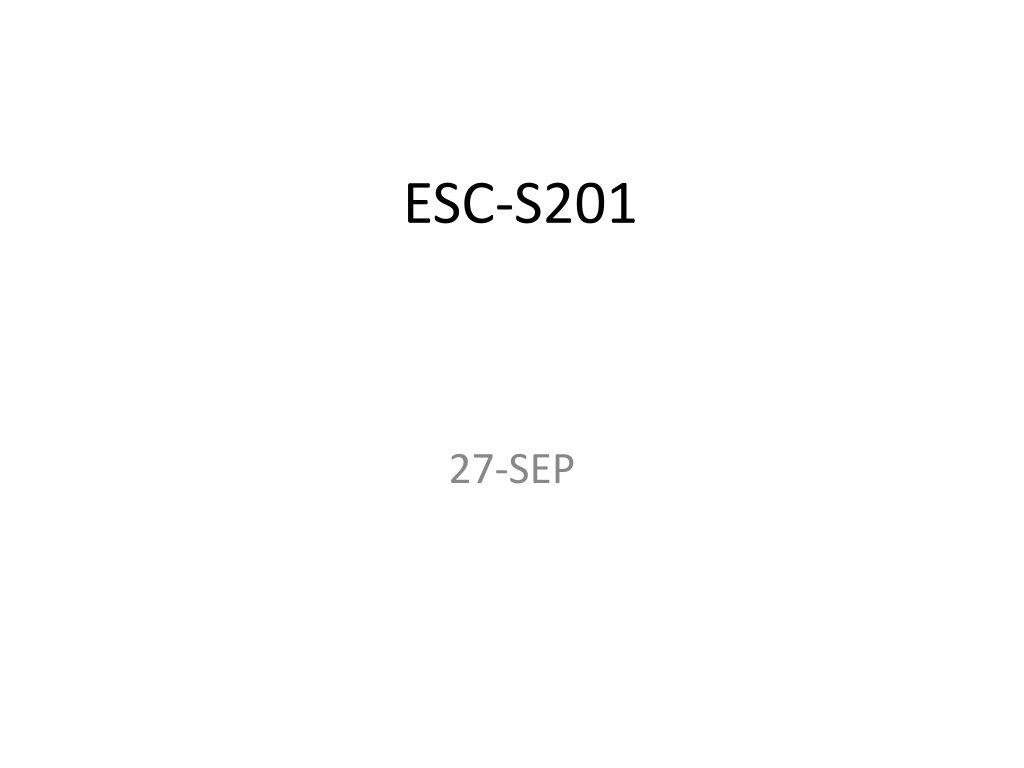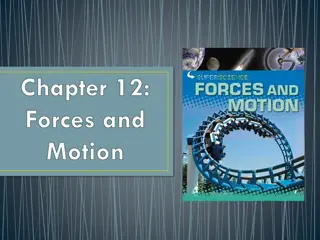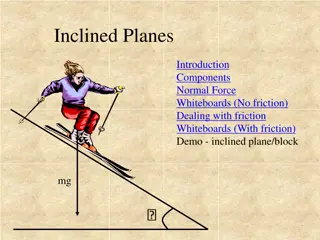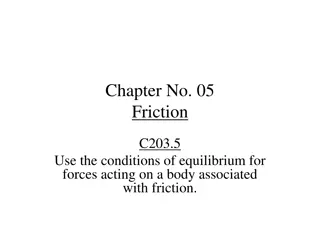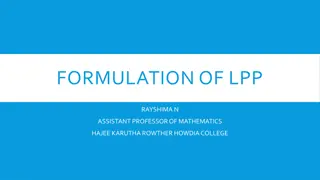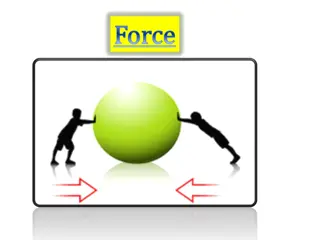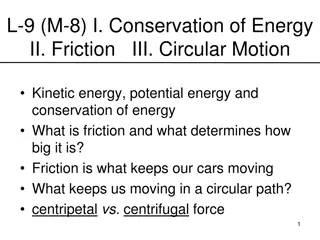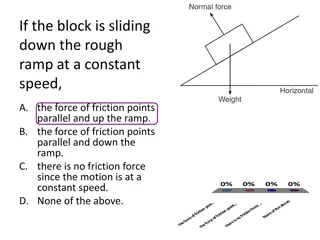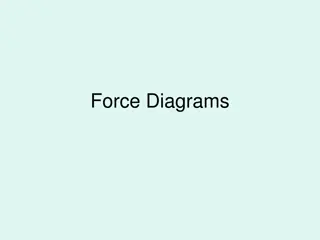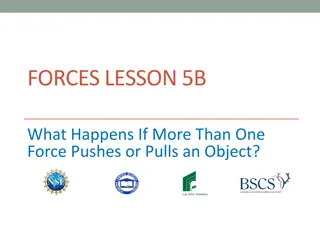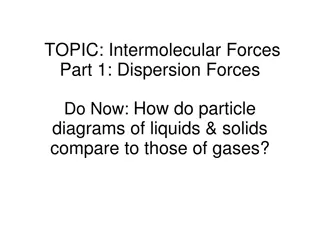Solving Friction Problems with Forces and Coefficients
In these physics problems, forces, friction, and coefficients are utilized to determine weight and movement of objects on inclined planes. The solution involves resolving forces, applying equilibrium principles, and calculating friction coefficients. Through detailed steps and calculations, the weight of the body, coefficient of friction, and the direction of block movement are found.
Download Presentation

Please find below an Image/Link to download the presentation.
The content on the website is provided AS IS for your information and personal use only. It may not be sold, licensed, or shared on other websites without obtaining consent from the author.If you encounter any issues during the download, it is possible that the publisher has removed the file from their server.
You are allowed to download the files provided on this website for personal or commercial use, subject to the condition that they are used lawfully. All files are the property of their respective owners.
The content on the website is provided AS IS for your information and personal use only. It may not be sold, licensed, or shared on other websites without obtaining consent from the author.
E N D
Presentation Transcript
ESC-S201 27-SEP
Friction problem 1. A pull of 180 N applied upwards at 300to a rough horizontal plane was required to just move a body resting on the plane while a push of 220 N applied along the same line of action was required to just move the same body downwards. Determine the weight of the body and the coefficient of friction. 220 N 180 N 300 300 W W Case-2 Case-1
Case-A 180 Sin (30 ) 1. First we resolve the 180 N force in Horizontal and vertical components. 2. Due to horizontal force 180 Cos (30) block tend to to oppose this motion. So floor will apply N 180 Cos (30 ) W move in direction of positive x axis. Fs 3. Since block is kept at floor therefore floor will try W a friction force on block towards left. c) Fs = s N a) Force equilibrium in x-direction: 180 * Cos (30) Fs = 0 Fs = 180 *0.866. Fs = 155.9 N b) Force equilibrium in y-direction : 155.9 = s (W - 90) N W + 180 sin (30)= 0 N = W - 90
Case-B Force equilibrium in x- direction. F s = 220 Cos (300) FBD 220 cos(30) Force equilibrium in y-direction. W N = W + 220 Sin( 300). Fs 220 sin(30) N Since block is about to move therefore, friction force act on the block is equal to maximum static Force acts on the block friction force. 1. N = Normal contact force. Max static friction force = 2. Fs = static friction force. 3. W = weight of the block. Coefficient of static friction x Normal Contact force. 4. 220 N applied force act at an angle of 300 . Fs = ( Fs )max = s N.
Friction problem 1. F s = 220 Cos (300) 2. N = W + 220 Sin( 300). 3. Fs = ( Fs )max = s N. By (1), s N = 220 Cos(300) s (W + 220 Sin( 300) ) = 220 Cos(300) Case-2 s (W-180sin(300)) = 180 * cos (300). Case-1 Answer W = 990 N s = 0.1722 Solve these two equation and get s and W.
Friction problem 2. Find whether block A is moving up or down the plane. Weight of block B = 600 N and Weight of block A = 300 N. Coefficient of limiting friction between plane AB and block A is 0.2. Coefficient of limiting friction between plane BC and block B is 0.25. Assume pulley as smooth. B 600 400 A C
Friction problem B 600 400 C A Total three cases possible: 1. Either both block is stationary. 2. Block A moves in downwards direction 3. Block A moves in upwards direction.
Friction problem CASE-1 : Either both block is stationary. B T 600 400 C A 600 N 1. Weight of block A = 300 N 2. Weight of block B = 600 N WA 1. Take component of weight parallel to surface AB: WA Sin ( 600 ) = 300 * 1.732 * 0.5 = 259.8 N 2. Take component of weight normal to surface AB: WA Cos ( 600 ) = 300 *0.5 = 150 N 3. Since block A
Friction problem If T < 259.8 N If T > 259.8 N T T N N Fs Fs Condition for static friction force Fs1 <= A N = 0.2*150 = 30 N
Friction problem If T < 259.8 N Condition for static friction force Fs 1 <= 75N T Assume T < 259.8 N N Fs1 1) Force equilibrium along y-axis : T + Fs1 = 259.8 N If T < 259.8 N Condition for static friction force Fs2 <= 114.9 N N T Assume T < 259.8 N Fs2 1) Force equilibrium along y-axis : T + Fs2 = 385.7 N
Friction problem T + Fs1 = 259.8 N T + Fs2 = 385.7 N - - - - Fs2 + Fs1 = - 385.7 N + 259.8 N Fs 1 <= 30N Fs2 Fs1 = 125.9 N Fs2 <= 114.9 N If my direction is correct then F Maximum value of Fs2 Fs1 = 114.9 N. So our direction of static friction force is incorrect.
Ladder problem 3. A ladder of length 4 m weighing 200 N is placed against a vertical wall. The coefficient of friction between the wall and the ladder is 0.2. and that between the floor and the ladder is 0.3.The ladder in addition to its own weight has to support a man weighing 600 N. at a distance of 3m from A. Calculate the minimum horizontal force to be applied at A to prevent slipping. 600 N B AB = 4 m C G AG = 2 m AC = 3 m 600 200 N P A AIM: Pmin = ??
Ladder problem Step-1 o DRAW FREE BODY DIAGRAM OF LADDER
Ladder problem Step-1 o DRAW FREE BODY DIAGRAM OF LADDER o Velocity direction of point A and B. 600 N B NB VB Fs2 600 200 N P A Fs1 VA NA At the time of slipping direction of velocity of point A and B are shown in above figure.
Ladder problem Step-2 o Moment equilibrium about point A
Ladder problem o Moment equilibrium about point A 1. Moment due to Normal force NB about point A. = Force x perpendicular distance from A to line of action of force NB 600 N B X NB 200 N C G Fs2 300 600 = NB x AX P Y A Fs1 AB = 4 m AG = 2 m AC = 3 m = NB x AB * Cos( 300 ) NA = NB x 4 * Cos( 300 ) = Fs2 x 4 x 0.5. Direction: Anticlockwise direction. Direction : Anticlockwise moment 2. Moment due to Friction force Fs2 about point A. = Force x perpendicular distance from A to line of action of force Fs2 = Fs2 x AY = Fs2 x AB Cos ( 600)
Ladder problem o Moment equilibrium about point A 3. Moment due to 600 N force act at point C about point A. 600 N B X NB 200 N C G Fs2 300 = Force x perpendicular distance of line of action of force 600 N from A. 600 P Y Z M A Fs1 AB = 4 m AG = 2 m AC = 3 m = 600 N x AZ NA = 600 N x 3 * Cos ( 600 ) m = 200 N x AM = 900 N m = 200 N x AG * Cos( 600) Direction : Clockwise moment = 200 N x 2 * 0.5 m 4. Moment due to 200 N force act at point G about point A. = 200 N m = Force x perpendicular distance of line of action of force 200N from A. Direction : Clockwise moment
Friction problem o Moment equilibrium about point A 4 * NB * Cos( 300 ) (ACW) + 2 * Fs2 ( ACW) + 900 (CW) + 200 (CW) = 0 Take anti clockwise moment as positive. 4 * NB * Cos( 300 ) + 2 * Fs2 - 900 - 200 = 0 4 * NB * Cos( 300 ) + 2 * Fs2 = 1100 At the time of slipping friction force Fs2 = B x NB 4 * NB * Cos( 300 ) + 2 * B * NB = 1100 B B 600 A B = Coefficient of friction between vertical wall and rod
Friction problem 1. Two identical blocks A and B are connected by a rod and they rest against vertical and horizontal planes respectively. If sliding impends when = 450 , determine the coefficient of friction, assuming it to be the same for both floor and wall. A B Answer = 0.414
